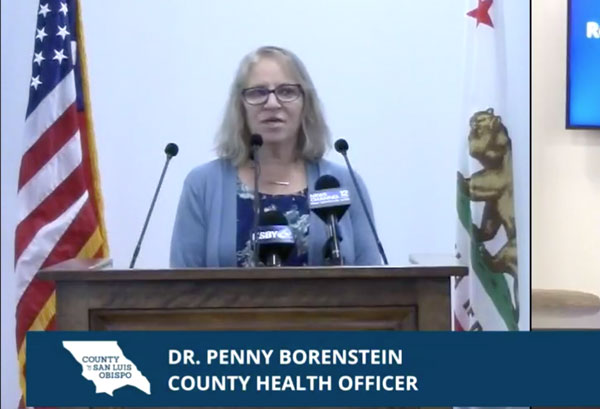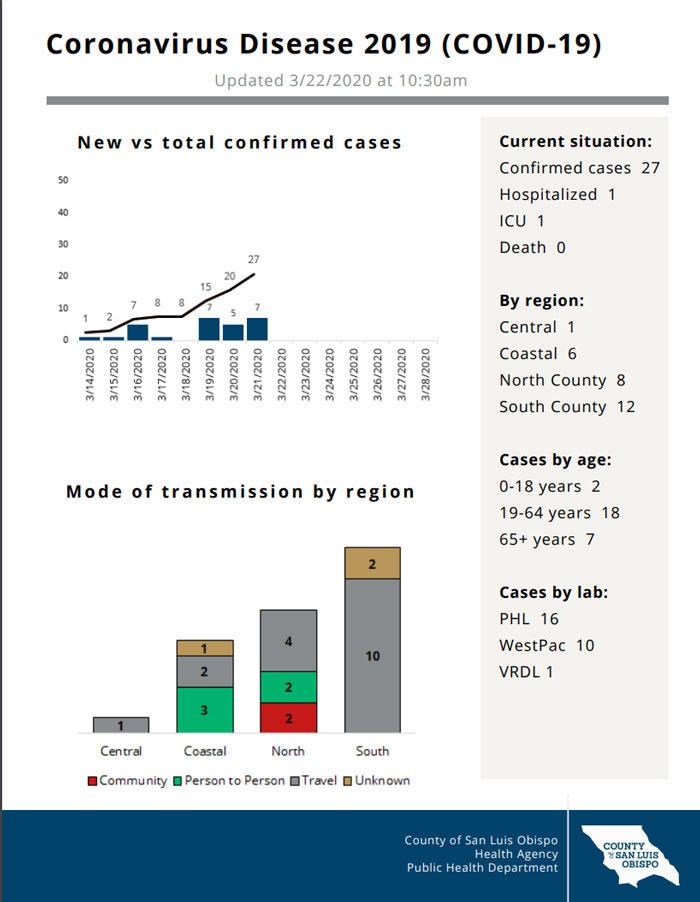COVID-19 update: 27 cases now confirmed in county – see new details
See the latest update here – COVID-19 update: 33 cases now confirmed in county – see new details
–On Sunday afternoon, the County of San Luis Obispo updated the community regarding the COVID-19 pandemic. At this time, 27 local residents have tested positive for the COVID-19 coronavirus. Two local patients have recovered from the virus, one is in an intensive care unit, most are recovering at home.
Distribution of COVID-19 cases in San Luis Obispo County
- North County cases – 8
- Coastal County cases – 6
- San Luis Obispo central cases – 1
- South County cases – 12
Ages of COVID-19 cases in San Luis Obispo County
- Age 0-18 years old – 2
- Age 19-64 years old – 18
- Age 65 years or older – 7
Cases of COVID-19 by status in San Luis Obispo County
- At home – 23
- Hospitalized – 1
- Hospitalized in intensive care – 1
- Recovered – 2
- Deaths – 0
Source of transmission of COVID-19 cases in San Luis Obispo County
- Travel related transmission – 17
- Known person-to-person transmission – 5 (most in households)
- Unknown community-acquired transmission – 2
- Unknown – 2
Cases of COVID-19 by testing laboratory
- SLO County Public Health Lab – 16
- WestPac – 10
- VRDL – 1
As of Sunday afternoon, the county reports conducting 275 COVID-19 tests. An unknown number of residents have been tested by private labs, the county reports.
After releasing the latest statistics, the county held a press conference Sunday afternoon at the county’s Joint Information Center at 1133 Kansas Avenue, San Luis Obispo, Calif.
“We now have our first two cases in children, both of those are of high school age and they are contacts of confirmed cases,” said County Public Health Officer Dr. Penny Borenstein.
As far as testing capability, “We are still testing the same high-priority groups and we still have sufficient supply, and we are expecting to get more in the early part of the week,” she said. The county is trying to increase testing capacity by getting a “high throughput machine” to be available at a local hospital, and getting a new point-of-care test to local providers, so tests may be done onsite at a clinic or hospital. They can provide test results in about 45 minutes, she said.
Borenstein discussed measures for infection control and said that “going to a grocery store or pumping your gas is not only of some of measure of concern because there may be other people in those facilities or people lined up in some fashion, but the actual material you touch and use while accessing these services, such as shopping carts or the gas pump handle is of some concern.” But that the vast majority of transmission of COVID-19 appears to be through direct contact with infected individuals rather than surfaces, she said. But surfaces may be a means of exposure, she said.
Health inspections, homeless population, domestic violence, gun sales
San Luis Obispo County Emergency Services Director Wade Horton said that starting on Monday, County Health inspectors will visit businesses who hold a permit issued by the health department to ensure the businesses are doing what they need to protect public health.
“Preventing the spread of the virus among our homeless population is one of our many priorities,” he said. “Today we are signing agreements with four motels throughout our region to provide housing to homeless individuals who are symptomatic or who have been diagnosed with COVID-19.” There are currently no homeless in the county diagnosed with the virus, he said.
Domestic violence calls are on the rise in the county, he said. “If you or a loved one need to talk to somebody about this, please call (855) 886-7473.”
Horton also announced that he had consulted with the San Luis Obispo County Sheriff, and determined that firearm shops may remain open, though the shops had originally been specifically listed among businesses to close their physical locations.
More guidelines regarding the current “Shelter at Home” order and other information are available at readyslo.org. The county order remains in effect, business operations are limited to essential services. See the list of businesses that are allowed to stay open under the county order.
The county asks residents to only purchase grocery items needed and not to hoard. Supply chains to local stores are in good condition, the county reports. No evictions of renters affected by the pandemic will be permitted at this time, the county says.
The county asks residents to maintain a distance of six feet between other people while waiting In line at grocery stores, pharmacies, or engaging in recreational activities.
Additional information from the county, state, federal government below:
County confirms Arroyo Grande High School student tests positive, may have exposed students
–On March 22, Arroyo Grande High School officials announced a 10th grade Arroyo Grande High School student tested positive for COVID-19. During a news briefing that took place on the same day, County Health Officer, Dr. Penny Borenstein acknowledged two high school-aged students tested positive for COVID-19 but did not confirm where the students attended school.
Borenstein now confirms two Arroyo Grande High School students have tested positive for COVID-19, including one 10th grader; and one 12th grader. Students may have been exposed to the 10th grader during the communicable period, which began on March 13, the final day prior to school closure. It is not believed that any students were exposed to the 12th grader as the estimated communicable period took place after Arroyo Grande High School closed to prevent the spread of the disease.
When dealing with a large school population, Borenstein says, “The county will take a balanced approach in notifying school administration and individuals who potentially had contact with infected individuals, while maintaining medical privacy.”
The county continues to conduct detailed investigations when learning of individuals who have tested positive for COVID-19, while being mindful of releasing information that would violate HIPAA practices, the county said in a news release.
SLO County Board of Supervisors meetings now closed to public attendance
–Based on guidance from the California Department of Public Health and the California Governor’s Officer, in order to minimize the spread of COVID-19, in-person public attendance will not be allowed at Board of Supervisors meetings until further notice.
This approach is consistent with the approach being taken across our State and nation. Rather than personally attending Board of Supervisors meetings, consider the following:
1. Observe the live stream of the Board of Supervisors meetings here.
2. Provide written comment on any matter within the Board’s subject matter jurisdiction, regardless of whether it is on the agenda for Board consideration or action. Submit your comment via email or U.S. Mail by 5 p.m. on the Monday prior to the Board meeting. You may submit comments via email to the Clerk of the Board at: ad_board_clerk@co.slo.ca.us. Your comment will be placed into the administrative record of the meeting.
3. Submit verbal comment by calling (805) 788-6638; state and spell your name, mention the agenda item number you are calling about and leave your comment. Verbal comments must be received by the Clerk of the Board no later than 9 a.m. on the morning of the noticed meeting and will be limited to 3 minutes per item. All comments received will be part of the record; however, not all messages left are guaranteed to be played back during the meeting itself.
For information about and updates regarding the Board of Supervisors meetings, please click here, or call the County Administrative Office at (805) 781-5011.
Governor issues order suspending some open meeting rules, noise ordinance rules, allows retired government employees to come back to work
–On March 21, California Governor Gavin Newsom issued Executive Order N-35-20 that relaxed/removed certain requirements that could impact the provision of public services/facilities. Restrictions on the employment of retired government employees have been suspended. The order also allows for certain communications between public officials outside of an open meeting. Lastly, the order provides for the extension of a number of statutory and regulatory deadlines, including the time within which an individual must file a Government Code claim against a public entity.
Executive Order N-35-20 relaxes local governments work hour limitations to any persons receiving a pension benefit from a public retirement system, including the limitation that a retired person does not serve within 180 days of retirement.
The order suspends any local ordinances, including noise ordinances, which may inhibit the delivery of food products, pharmaceuticals and other emergency necessities distributed through grocery stores and other retail or institutional channels.
The governor has also suspended certain Brown Act requirements and authorized all members of a local or state legislative body to receive updates from and ask questions of federal, state and local officials related to COVID-19. A majority of an elected body can now be briefed on this emergency without public notification of a meeting. The order does not permit members of said bodies to take action or discuss amongst themselves any other matter without otherwise complying with the Brown Act.
Finally, the Order extends the time to present a claim against a public entity and the time for the State Department of General Services to act upon such a claim to 60 days.
COVID-19 in California by the numbers
The following numbers reflect the information received from local health jurisdictions as of 2 p.m., March 21.
- 1,468 – Positive cases
- 27 – Deaths (including one non-California resident)
- 113 – Travel-related
- 145 – Person to person
- 408 – Community transmission
- 778 – Under investigation
- 24 – Positive cases related to federal repatriation flights
Ages of all confirmed positive cases: 1,468
- Age 0-17: 23 cases
- Age 18-64: 1066 cases
- Age 65+: 369 cases
- Unknown: 10 cases
Testing in California
–As of 2 p.m. March 21, approximately 26,200 tests had been conducted in California. This includes the latest numbers California has received from commercial and private labs. At least 13,467 results have been received and another 12,700+ are pending. Twenty-two state and county health labs are currently testing.
In order to better focus public health resources on the changing needs of California communities, the state is no longer collecting information about California travelers returning from countries that have confirmed COVID-19 outbreaks. Community transmission of COVID-19 has been identified in California since late February, and since early March, most of the confirmed cases in the state were not related to travel outside of the United States.
President Trump approves major disaster declaration for California
WASHINGTON — FEMA announced that federal emergency aid has been made available for the state of California to supplement state, tribal and local recovery efforts in the areas affected by the Coronavirus Disease 2019 (COVID-19) pandemic beginning on January 20, 2020, and continuing.
The President’s action makes federal funding available for Crisis Counseling for affected individuals in all areas of the state of California.
Federal funding is also available to state, tribal, and eligible local governments and certain private nonprofit organizations on a cost-sharing basis for emergency protective measures (Category B), including direct federal assistance under Public Assistance, for all areas affected by COVID-19 in the state of California. The federal cost-share is 75 percent.
What is the cause of COVID-19 transmission
–Transmission of the COVID-19 virus appears to be caused by close and prolonged contact, Borenstein said. The greater the illness has affected someone, the more likely they are to transmit it to other people, she said. Asymptomatic transmission, if occurring at all, is a minor proportion of infections, she said. Airborne infection appears to be limited to someone infected who coughs or sneezes and vapor droplets may linger for a short period of time. But neither asymptomatic transmission nor airborne transmission appear to be a dominant means of transmission, she said. The virus does tend to transfer well with human contact, like shaking hands, and linger on hard surfaces, studies have shown.
How can people protect themselves
Every person has a role to play. Protecting yourself and your family comes down to common sense:
- Staying home except for essential activities – “Shelter at home“
- Washing hands with soap and water for a minimum of 20 seconds.
- Avoiding touching eyes, nose or mouth with unwashed hands.
- Cover a cough or sneeze with your sleeve, or disposable tissue. Wash your hands afterward.
- Avoiding close contact with people who are sick.
- Staying away from work, school or other people if you become sick with respiratory symptoms like fever and cough.
- Practicing social distancing.
- Following guidance from public health officials.
What to do if you think you’re sick
Call ahead: If you are experiencing symptoms of COVID-19 (fever, cough or shortness of breath) and may have had contact with a person with COVID-19, or recently traveled to countries with apparent community spread, call your health care provider before seeking medical care so that appropriate precautions can be taken.
San Luis Obispo County’s urgent communicable disease line is (805) 781-4553.
- Follow all local COVID-19 coronavirus news updates
- San Luis Obispo County COVID-19 website – readyslo.org
Comments
Scott Brennan is the publisher of this newspaper and founder of Access Publishing. Follow him on Twitter, LinkedIn, or follow his blog.























